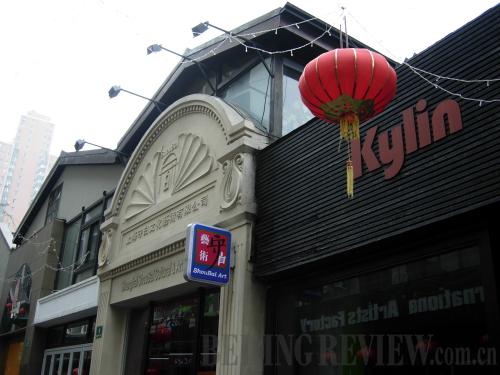|
 |
|
MIX CULTURE: Old-fashiond shops decorated with a red latern at Lane 210 of Taikang Road in Shanghai (ZHANG JING) |
The Luwan District government, artists, entrepreneurs and people of insight have made great contributions to the aesthetic and commercial success of Tianzifang. In 2006, an industrial association named Tianzifang China's Best Creative Industry Zone, the only award winner in Shanghai.
"We are highly selective about who can invest here," Wu said. "On one hand, we are aiming to better retain the original culture of the shikumen, and on the other hand, we want to promote the flavor of the creative zone. Besides, the subtle and feminine way of operation is more suitable to female investors, as almost 80 percent of the entrepreneurs here are women."
And a dream
Although Wu Meisen's dream certainly boosted the prosperity of Tianzifang, the reform and opening-up policy and the Shanghai Municipal Government's determination to preserve haipai culture (literally "Shanghai-style culture") also contributed to the success of Taikang Road.
The road is crowded and tiny but has profound cultural heritage. Considering this characteristic, dilemmas arose when choosing its mode of transformation. With the help of the Economic Committee of Shanghai's Municipal Government, Li Wuwei, head of the Economic Research Institute under Shanghai's Academy of Social Sciences, designed a special project to research the experiences of Tianzifang, producing a theory on creative industry zones that has been introduced into universities' curriculum.
Inspired by Tianzifang, more than 100 old factories were subsequently restored into new creative zones in Shanghai.
Currently, Tianzifang covers an area of 20,000 square meters and enjoys wide popularity. Until now, 137 independently managed art and design enterprises have set up shops in old factories and 188 in local residences.
On March 1, 2010, the Shanghai Municipal Government named Tianzifang a state-level 3A tourist destination, integrating the function of artistic creativity and leisure tourism.
According to statistics, Tianzifeng receives an average of 5,000 to 6,000 visitors per day. The art zone set a record when 66 sightseeing buses brought thousands of tourists in one day.
Since it renovated old factories and residential buildings on the basis of Shanghai culture, Tianzifang has applied to be recognized as world intangible heritage. As a place showcasing "Better City, Better Life," the theme of the Shanghai 2010 World Expo, Tianzifang has been busy preparing to welcome guests from all over the world.
The Luwan Government attaches great importance to the safety of the shabby old buildings, strictly limiting the number of guests per square meter in the restaurants. Moreover, Shanghai Metro Line 9 constructed Tianzifang Station in preparation for the Expo. Across from Lane 210, a modern central business district is under construction.
The primitive atmosphere and the sense of humanity contribute a lot to Tianzifang's success, which is driven by tourism and investment from abroad. People from 26 nations and areas all over the world have set up businesses in Tianzifang.
According to Wu, Tianzifang is like "a tiny United Nations when it comes to culture." Visitors walking down the lane can spot cultural styles from various places, such as ancient Shanghai, mysterious Denmark, cool Hokkaido of Japan, and the gorgeous Aegean Sea.
Attracted by Shanghai culture, foreigners rush to Tianzifang, bringing their own cultures with them. The result is a fabulous cultural integration between West and East.
Japanese are the largest in number and were the first to move in. Several years ago, a Japanese woman and her daughter rented a residence from the local people and became the first foreign shop owners in Tianzifang. Now there are 25 Japanese people running 20 shops, and they have launched a Japanese association in the lane.
As the first tenant of the old factories and residential buildings, Wu said his community development work is more like volunteering.
Having a humble heart, Wu has realized his dream in Shanghai's old-fashioned lanes, and is sharing it with others who come to Tianzifang. | 